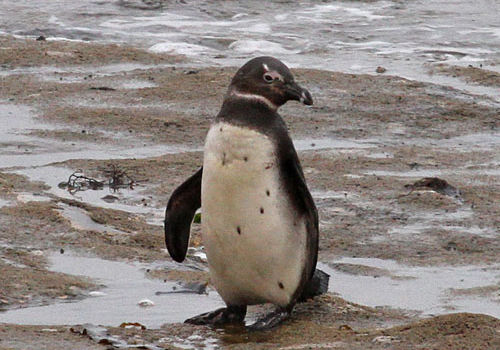
African penguin
Spheniscus demersusAfrican penguin
Introduction: The African penguin (Spheniscus demersus) or Jackass penguin inhabit inshore marine waters, breeding ashore at coastal islands and isolated mainland locations. Many mainland Namibian colonies inhabit inaccessible caves along the coast. Walks upright on land, hopping over small obstacles and sliding down inclines. General habits include constant preening, shaking, stretching, rapid flipper flapping, yawning and rubbing the head on neck.
Distribution: From Roastbeef Island extending north including Luderitz (Penguin Island) to Sandwich Harbour, Swakopmund and Walvis Bay, Cape Cross as far north as Cape Fria.
Diet: Penguins dive for sardines, gobies, mackerel, cephalopods, hake and other fish.
Description: Predominately black and white colouration. Black shiny upperparts and median crown stripe and nape. Wide white supercilium from in front of the eye extending around the back of ear coverts, leading down the sides of the neck to merge into the white breast. The remainder of the face and throat is black in colour as are the upper sides of the flippers. The undersides of the flippers are mottled black and white. Eyes are brown, legs and feet black with a touch of blotched pink.
Breeding: Breeds at Hollams Bird Island as well as Cape Cross if Cape fur seals allow space. A nest is burrowed in guano or the sand where 1 to 3 eggs are laid September to December and incubated for around 40 days. Chicks often starved to death by lack of food or burrow collapse. Mole snakes eat their penguin eggs and other predators include kelp gulls and African sacred ibises.
Size: 65cm.
Weight: 3.5kg.
Flipper: 18cm.
Klein Windhoek

